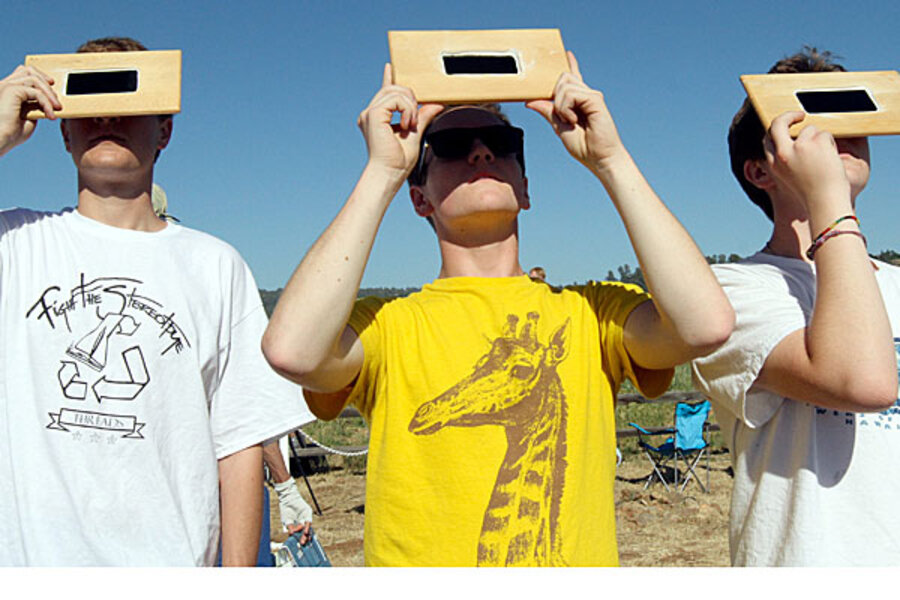Solar eclipse Sunday: When and where to watch
Loading...
In the US, anyone located east of the Appalachian mountains should be able to catch sight of a partial solar eclipse shortly after sunrise.
The farther north, the bigger the bite out of the sun.
From Boston, for example, more than half the sun will be missing (between 6:20 a.m. sunrise and 7:11 a.m.) From Washington D.C., about 35 percent of the sun will be in the moon's shadow (sunrise at 6:38 a.m, eclipse ends at 7:08 a.m.). And Miami is looking at about the same view, based on the calculations by cartographer Michael Zeiler. For the likely eclipse view from your city, check out Zeiler's website.
Parts of the Caribbean and eastern South America will also see a partial eclipse at sunrise.
But serious solar eclipse aficionados are positioning themselves in central Africa. That's where the eclipse will be an annular or ring eclipse at its start and a total eclipse, briefly, later on.The path of the umbra will pass over equatorial Africa (Gabon at about 2:51 pm local time, Congo, Democratic Republic of the Congo, Uganda, Ethiopia, Kenya at about 5:25 p.m., and Somalia) in the afternoon hours, according to Earthsky.org.
In Gabon, the moon's umbra will be just 29 miles wide and the total solar eclipse will last about 68 seconds. By the time the moon's shadow reaches Somalia, the total eclipse will last just one second before sunset.
Of course, the truly dedicated eclipse chaser would take a boat into the Atlantic, about 200 miles off the coast of Liberia, where the total solar eclipse will last 99 seconds.
Check out this cool NASA animation of the moon's shadow during the eclipse as it crosses the US, the Atlantic, and Africa.
But amateur eclipse watchers are warned: To avoid eye damage, always use a solar filter when looking at the sun, whether during a partial eclipse or at any other time. Only use materials specifically manufactured for safe solar viewing or #14 arcwelder's glass, says Sky & Telescope. And the site warns: "Do not use “filters” such as smoked glass, stacked sunglasses, polarized filters, camera filters, candy wrappers, or compact discs. They might reduce the Sun’s glare, but enough harmful radiation can sneak through to damage your eyes."
The site also offers an inexpensive method of indirectly watching a solar eclipse:
"The simplest safe solar-viewing method is to watch the Sun's image projected onto a piece of paper. Poke a small hole in an index card with a pencil point, face it toward the Sun, and hold a second card three or four feet behind it in its shadow. The hole will project a small image of the Sun's disk onto the lower card."
Sunday's eclipse will be the second solar eclipse of 2013. This eclipse is called a hybrid because it begins on the US and South American east coasts as an annular or ring eclipse and becomes a total eclipse when the moon's shadow crosses the Atlantic and traces across central Africa.
A solar eclipse results when the moon swings directly in between the sun and Earth, The dark cone-shaped shadow created by the moon is called the umbra. A fainter, wider shadow outside the umbra is called the penumbra. All places on Earth within the umbra see a total solar eclipse, and all places within the penumbra see a partial eclipse of the sun, explains Earthsky.org.








